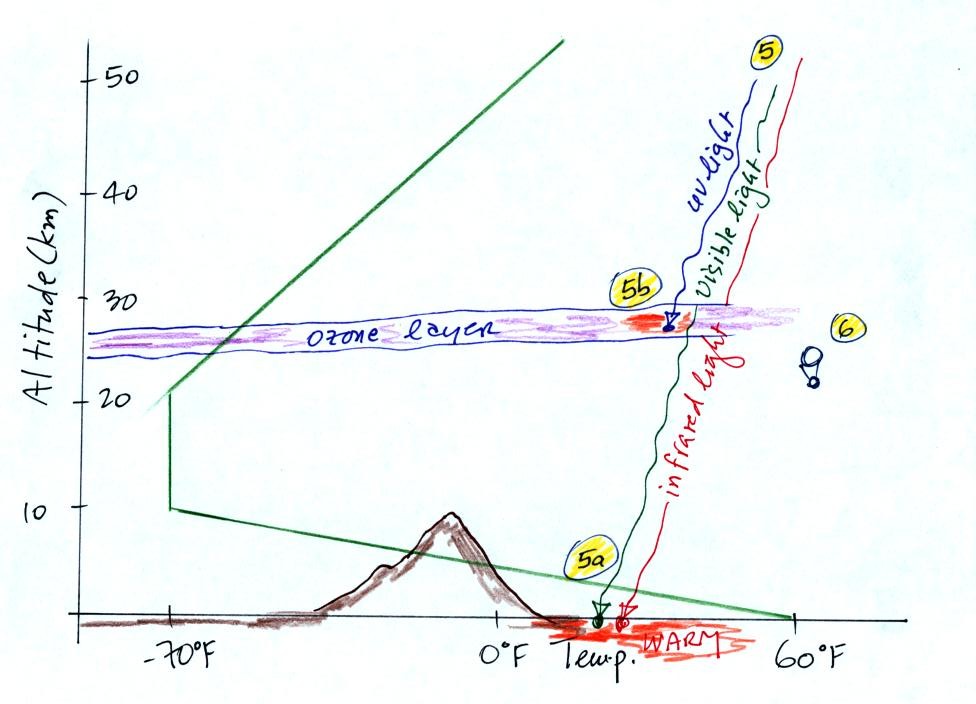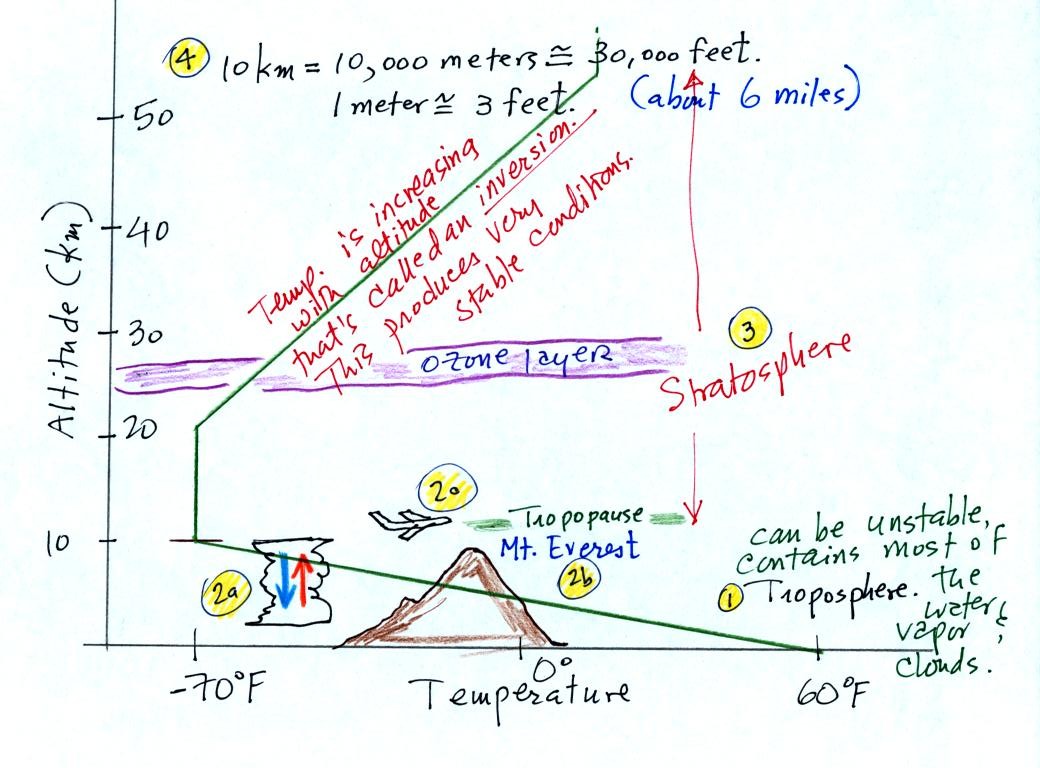Wednesday, Feb. 4, 2009
click here to download today's notes in
a more printer friendly format
Mykonos from the Fleet
Foxes was featured before class today.
The Experiment #1 reports are due next Monday. Try to get
your materials back this week so that you can pick up the supplementary
information handout. The graduated cylinders from Expt. #1 also needed
for Experiment #2. The Expt. #2 materials should be handed out
next week.
If there
were a real quiz today you would have the entire class period to work
on it. It's just a Practice Quiz today however, so we did cover a
little bit of new material first.
So far we
have looked at how pressure and air density change with increasing
altitude. Now we will look how air temperature changes with
altitude. The figure drawn in
class has been split into two parts and redrawn for improved
clarity (actually I just took the figures from the Fall 2008 semester,
which were themselves probably taken from the Spring 2008 class).
The numbers were added after class
The atmosphere can be split
into layers
depending on whether
temperature is increasing or decreasing with increasing altitude.
The two lowest layers are shown in the figure above. There are
additional layers (the mesosphere and the thermosphere) above 50 km but
we won't worry about them.
1. We live in
the troposphere. The troposphere is found, on average, between 0
and about 10 km altitude, and is where temperature usually decreases
with
increasing altitude. [the troposphere is usually a little higher
in the tropics and lower at polar latitudes]
The troposphere contains most of the water vapor
in the atmosphere (the water vapor comes from evaporation of ocean
water) and is
where most of the clouds and weather occurs. The
troposphere can be stable or unstable (tropo means to turn over and
refers to the fact that air can move up and down in the
troposphere).
2a. The thunderstorm shown in
the figure indicates unstable conditions, meaning that strong up and
down air motions are occurring. When the thunderstorm reaches the
top of the troposphere, it runs into the stable stratosphere. The
air can't continue to rise into the stable stratosphere so the cloud
flattens out and forms an anvil (anvil is the name given to the flat
top of the thunderstorm). The
flat anvil top is something
that you can go outside and see and often marks the top of the
troposphere.
2b. The summit of Mt. Everest is a little over 29,000
ft. tall and is
close to the top of the troposphere.
2c. Cruising altitude in a passenger jet is usually between
30,000 and 40,000, near or just above the top of the troposphere, and
at the bottom of the stratosphere.
3. Temperature remains constant between 10 and 20 km
and then
increases with increasing altitude between 20 and 50 km. These
two sections form the stratosphere. The stratosphere is a
very stable air layer. Increasing temperature with increasing
altitude is called an
inversion. This is what makes the stratosphere so stable.
4. A kilometer is one
thousand meters. Since 1 meter is about 3 feet, 10 km is about
30,000 feet. There are 5280 feet in a mile so this is about 6
miles.

5. Sunlight is a mixture of ultraviolet (7%),
visible (44%), and
infrared light (49%). We can see the visible light.
5a. Much of the sunlight arriving at the top of
the atmosphere passes through the atmosphere and is absorbed at the
ground. This warms the ground. The air in contact with the
ground is warmer than air just above. As you get further and
further from the warm ground,
the air is
colder and colder. This
explains why air temperature decreases with increasing altitude.
5b. How do you explain increasing temperature with
increasing
altitude in the stratosphere.
The ozone layer is found in the stratosphere
(peak concentrations are found near 25 km altitude). Absorption
of
ultraviolet light by ozone warms the air in the stratosphere and
explains why the air can warm. The air in the stratosphere is
much less dense (thinner) than in the troposphere. It doesn't
take as much energy to warm this thin air as it would to warm denser
air closer to the ground.
6. That's a manned
balloon (it wasn't shown in class);
Auguste Piccard and Paul Kipfer are
inside. They were to first men to travel into the
stratosphere (see pps 31 & 32 in
the photocopied Class Notes). We'll see a short video showing
part of their adventure at some point in the next week or
so. It really was quite a daring trip at the time, and they very
nearly didn't survive it.


